- Administrator
- Albums and Singles
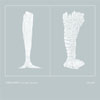 23five came into the public eye as the label vehicle for soundartist-types, peddling the kind of stuff I'd see in the MoMA gift shopand pass by thinking it just wouldn't be the same outside an austeregallery space. Now only 6 releases into stride, the label has proved mewrong several times over. One needs only to hear Furudate &Zbigniew's World As Will II to see why. The opening minutes ofCoelacanth's sophomore release, however, left me with second, or ratherthird, thoughts. The Glass Sponge begins with a sparse scraping,thumping, and clanging that seems on the brink the ever-arty black holeof inaccessibility. After a few minutes, droning bell tones andtempered feedback ease their way in, making the piece more substantialbefore, as quickly as it began, the music fades into silence. Thoseopening bits were merely a prelude to the real meat of track, a sort ofsecond act comprised of layered static and an enriched texture oflulling feedback and prolonged bell tones. Stuttering vocal utteringsrise from drone and static layers that sound truly oceanic. Song titleslike "The Leaden Sea" and "The Violet Shell and Its Raft" lend a marinetheme to The Glass Sponge that feels apt in relation to the music. (Thename Coelacanth, also, refers to a prehistoric fish recently discoveredto still exist). All four tracks exhibit an approach to drone musicthat is both texturally rich and emotionally resonant. Tracks rangefrom gentle, inviting trips across static that gurgles and glimmerslike actual liquid to eerie passages where hollow drones and squealingfeedback rise from the depths. The Glass Sponge is host to a multitudeof bizarre, untraceable sounds as well. Various throbbings, tinkerings,and knockings find comfortable home in Coelacanth's sound world, givenoverture in the album's first moments, making it increasingly hard tobelieve that any of this was gathered from public performance as thenotes describe. This is beautiful, thoroughly engaging, and uniquemusic, no doubt more appropriate headphone music for pretending yourbed is a liferaft than for strolling the museum floor.
23five came into the public eye as the label vehicle for soundartist-types, peddling the kind of stuff I'd see in the MoMA gift shopand pass by thinking it just wouldn't be the same outside an austeregallery space. Now only 6 releases into stride, the label has proved mewrong several times over. One needs only to hear Furudate &Zbigniew's World As Will II to see why. The opening minutes ofCoelacanth's sophomore release, however, left me with second, or ratherthird, thoughts. The Glass Sponge begins with a sparse scraping,thumping, and clanging that seems on the brink the ever-arty black holeof inaccessibility. After a few minutes, droning bell tones andtempered feedback ease their way in, making the piece more substantialbefore, as quickly as it began, the music fades into silence. Thoseopening bits were merely a prelude to the real meat of track, a sort ofsecond act comprised of layered static and an enriched texture oflulling feedback and prolonged bell tones. Stuttering vocal utteringsrise from drone and static layers that sound truly oceanic. Song titleslike "The Leaden Sea" and "The Violet Shell and Its Raft" lend a marinetheme to The Glass Sponge that feels apt in relation to the music. (Thename Coelacanth, also, refers to a prehistoric fish recently discoveredto still exist). All four tracks exhibit an approach to drone musicthat is both texturally rich and emotionally resonant. Tracks rangefrom gentle, inviting trips across static that gurgles and glimmerslike actual liquid to eerie passages where hollow drones and squealingfeedback rise from the depths. The Glass Sponge is host to a multitudeof bizarre, untraceable sounds as well. Various throbbings, tinkerings,and knockings find comfortable home in Coelacanth's sound world, givenoverture in the album's first moments, making it increasingly hard tobelieve that any of this was gathered from public performance as thenotes describe. This is beautiful, thoroughly engaging, and uniquemusic, no doubt more appropriate headphone music for pretending yourbed is a liferaft than for strolling the museum floor. samples:
Read More
- Administrator
- Albums and Singles
 The air is thick, muggy, and full of nervous chatter. The congregationfinds their seats with the help of ushers dressed in black suits,polite in their assistance and insistence that the growing crowd findtheir seats. The tent is makeshift at best, made from old bed sheetsand a few cracks in the seams are visible to those who look above. Noone is sure what to expect. They've heard the tales of this newminister and his new gospel, but they are apprehensive, perhaps even alittle frightened at the prospect. Then, suddenly, the lights dim, andthe stage explodes with horns, guitar, bass, and heavy percussion. Asthe lights restore the minister sings, no, howlsthe sermon with a boogie that is just shy of satanic, and thecongregation can't help but rise to their feet and join in with theminimal choir that accompanies him. Casey Meehan is that minister, andhis songs aren't the old or new testament, but they are lessons for theweak nonetheless. He sings of being baptised, of being born again, andwith titles like "Who Will Be Saved?" and "Do Right" his mission isclear. He may not be of a formal religion, but he is here to shepherdthe meek through the valley, and he will do so with a bit of Dixie, abit of Storyville, New Orleans, and a lot of moxy and sensual vocalprowess reminiscent of Mark Sandman and Greg Dulli. These songs are thelessons of a man who has been through it all, who sees the masks we allput on and who wants to shatter them, hurling a reality with the forceof a fastball; and like any good evangelist he has sinned as much asthose he tries to save. His band, the Delta Still, are a tight, fierceensemble, and the songs are punishing in places and delicate in others:whatever it takes to get the message out right. The instrumentals aremassive, and through it all Meehan carries the weight with ease, sexingthe microphone for all its worth. For his first record, Meehan isshooting out of the gate, heading down the track at full speed. Catchhim if you can.
The air is thick, muggy, and full of nervous chatter. The congregationfinds their seats with the help of ushers dressed in black suits,polite in their assistance and insistence that the growing crowd findtheir seats. The tent is makeshift at best, made from old bed sheetsand a few cracks in the seams are visible to those who look above. Noone is sure what to expect. They've heard the tales of this newminister and his new gospel, but they are apprehensive, perhaps even alittle frightened at the prospect. Then, suddenly, the lights dim, andthe stage explodes with horns, guitar, bass, and heavy percussion. Asthe lights restore the minister sings, no, howlsthe sermon with a boogie that is just shy of satanic, and thecongregation can't help but rise to their feet and join in with theminimal choir that accompanies him. Casey Meehan is that minister, andhis songs aren't the old or new testament, but they are lessons for theweak nonetheless. He sings of being baptised, of being born again, andwith titles like "Who Will Be Saved?" and "Do Right" his mission isclear. He may not be of a formal religion, but he is here to shepherdthe meek through the valley, and he will do so with a bit of Dixie, abit of Storyville, New Orleans, and a lot of moxy and sensual vocalprowess reminiscent of Mark Sandman and Greg Dulli. These songs are thelessons of a man who has been through it all, who sees the masks we allput on and who wants to shatter them, hurling a reality with the forceof a fastball; and like any good evangelist he has sinned as much asthose he tries to save. His band, the Delta Still, are a tight, fierceensemble, and the songs are punishing in places and delicate in others:whatever it takes to get the message out right. The instrumentals aremassive, and through it all Meehan carries the weight with ease, sexingthe microphone for all its worth. For his first record, Meehan isshooting out of the gate, heading down the track at full speed. Catchhim if you can.samples:
Read More
- Administrator
- Albums and Singles
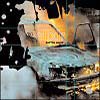 Here is another electronic, beat-based album that plays the game of "Ilove it/I hate it." The atmosphere is mostly dark, the beats thick andchugging, and the melodies somehow buried inside walls of static noiseand time-warped samples. There's the first problem: sometimes themelodies never get a chance to come out and play. As a result, I'm leftlistening to a somewhat boring, somewhat repetitive drum track thatdoesn't have the power to carry the song by itself. Unfortunately, thealbum is produced in such a way that each song inevitably has someincredible sounds on it but they're completely attenuated by the waythey're thrown into the backgroud and lost beneath a plethora ofeffects. But then, amazingly, all that wishy-washy noise comes togetherfor a few brief moments and gives birth to an explosion that comesclose to relieving the tension and weariness of the first few minutesof the song. This is how "Flesh Wound" opens up the album and it seguesinto the infinitely more entertaining "Gargantuan." I imagine one ofthose dolls that has a slinky for a neck bopping around to this rubberyand dynamic wall of beats only to have a stick of dynamite send it intothe great beyond. "Gargantuan" has nearly the same production style as"Flesh Wound," but manages to pull it off by allowing the repeatingdrum and melody patterns to weave a bit more intricate and diverse bodyof sound. "Boiled In Blood" is a bit more low-key than anything else onthe album and it provides a nice break from the havoc of the first twotracks. It unfortunately gives way to more standard four-on-the-floordance music that sounds horribly distorted and only covers up whatseems to be the most interesting elements dying in the background. Andso this process continues throughout the duration of Don't Be Scared.I either love it or I hate it. Not much changes in terms of production:it's all pretty muddy and eventually this makes the entire album feelfar too homogenous. The formula either works for some of the songs orit doesn't. This up and down experience ends up making the whole albumfeel dull; it's just hard to sit down and listen to the whole thing allthe way through.
Here is another electronic, beat-based album that plays the game of "Ilove it/I hate it." The atmosphere is mostly dark, the beats thick andchugging, and the melodies somehow buried inside walls of static noiseand time-warped samples. There's the first problem: sometimes themelodies never get a chance to come out and play. As a result, I'm leftlistening to a somewhat boring, somewhat repetitive drum track thatdoesn't have the power to carry the song by itself. Unfortunately, thealbum is produced in such a way that each song inevitably has someincredible sounds on it but they're completely attenuated by the waythey're thrown into the backgroud and lost beneath a plethora ofeffects. But then, amazingly, all that wishy-washy noise comes togetherfor a few brief moments and gives birth to an explosion that comesclose to relieving the tension and weariness of the first few minutesof the song. This is how "Flesh Wound" opens up the album and it seguesinto the infinitely more entertaining "Gargantuan." I imagine one ofthose dolls that has a slinky for a neck bopping around to this rubberyand dynamic wall of beats only to have a stick of dynamite send it intothe great beyond. "Gargantuan" has nearly the same production style as"Flesh Wound," but manages to pull it off by allowing the repeatingdrum and melody patterns to weave a bit more intricate and diverse bodyof sound. "Boiled In Blood" is a bit more low-key than anything else onthe album and it provides a nice break from the havoc of the first twotracks. It unfortunately gives way to more standard four-on-the-floordance music that sounds horribly distorted and only covers up whatseems to be the most interesting elements dying in the background. Andso this process continues throughout the duration of Don't Be Scared.I either love it or I hate it. Not much changes in terms of production:it's all pretty muddy and eventually this makes the entire album feelfar too homogenous. The formula either works for some of the songs orit doesn't. This up and down experience ends up making the whole albumfeel dull; it's just hard to sit down and listen to the whole thing allthe way through.samples:
Read More
- Administrator
- Albums and Singles
The recordings made by Christoph Heeman and Achim Flaam as HirscheNichts Auf Sofa has an appealingly built-in obsolescence. The bulk ofthe original catalog was released in small cassette and vinyl editionson Germany's DOM records, and with the exception of the five LPsrecently re-released in deluxe CD editions, most of the music remainsextremely scarce, making it great fodder for obsessive collectors.Unfortunately, many HNAS-related satellite projects such as MiesesGegonge, Duka Bass Band and Speck Nusseck have remained unreleased andlargely ignored. Recently G. Gonge Produktionen released this series ofCD-Rs, issuing six of the rarest DOM cassettes. Be warned: these discsare unofficial bootlegs, the original recordings have not beendigitally remastered, there are no bonus tracks and the packagingconsists of xeroxes of the original tape sleeves. Despite theselimitations, it's great to be able to hear the music again for thefirst time. Listening to these recordings 20 years after makes menostalgic for a lost age when esoteric and experimental underground DIYcassette labels flourished, not yet having been rendered obsolete bythe digital revolution. Creeping into this world of throwaway musiqueconcrete, off-kilter improvisation and drug-addled musical in-jokes islike rummaging through the dusty attic of a 90-year-old schizophrenicwho obsessively saves everything; it's a series of clues with nosolution, flashes of momentary inspiration and frustratingly stillbornideas. In short, the stuff of life.
MIESES GEGONGE, "LIVE" 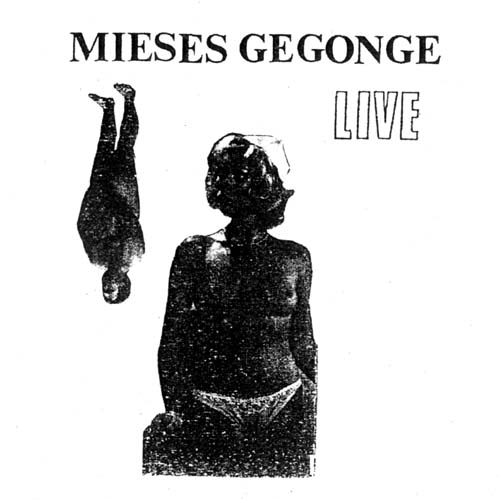 Mieses Gegonge are something of a mystery, but they appear to be asister group to HNAS, having shared the credit for the first HNAS albumAbwassermusik. The material on this CD is culled from two liveperformances in 1985. The sound is very strange indeed: a twistedcombination of arrhythmic percussion together with horribly phased anddistorted vocals. The treated voices and drums are immediatelyreminiscent of the "psych-out" sections of classic Can constructionslike "Halleluwah" and "Aumgn." However, Mieses Gegonge is all psych-outwith no breaks for coherence. Bizarre chants and ululations quaver andripple across layers of randomly beaten skins and gongs, reverbed andwarped into oblivion. If anyone attending these performances wasn't onat least three hits of fine Dusseldorf acid, I feel sorry for them. Therecording is shitty and wracked with distortion, which adds interestingbursts of high-frequency noise that contribute to the lunacy. Imagine apost-lobotomy 23 Skidoo trying to cover The Master Musicians of Jajoukawith nothing but a saw and a zither and William Bennett playing oneroom over, and you might begin to approximate the experience of Live.It's a uniquely fucked sound that will appeal to jaded listenerslooking for a surreal thrill.
Mieses Gegonge are something of a mystery, but they appear to be asister group to HNAS, having shared the credit for the first HNAS albumAbwassermusik. The material on this CD is culled from two liveperformances in 1985. The sound is very strange indeed: a twistedcombination of arrhythmic percussion together with horribly phased anddistorted vocals. The treated voices and drums are immediatelyreminiscent of the "psych-out" sections of classic Can constructionslike "Halleluwah" and "Aumgn." However, Mieses Gegonge is all psych-outwith no breaks for coherence. Bizarre chants and ululations quaver andripple across layers of randomly beaten skins and gongs, reverbed andwarped into oblivion. If anyone attending these performances wasn't onat least three hits of fine Dusseldorf acid, I feel sorry for them. Therecording is shitty and wracked with distortion, which adds interestingbursts of high-frequency noise that contribute to the lunacy. Imagine apost-lobotomy 23 Skidoo trying to cover The Master Musicians of Jajoukawith nothing but a saw and a zither and William Bennett playing oneroom over, and you might begin to approximate the experience of Live.It's a uniquely fucked sound that will appeal to jaded listenerslooking for a surreal thrill.
samples:
DUKA BASS BAND, "FRAULEIN CASANOVA"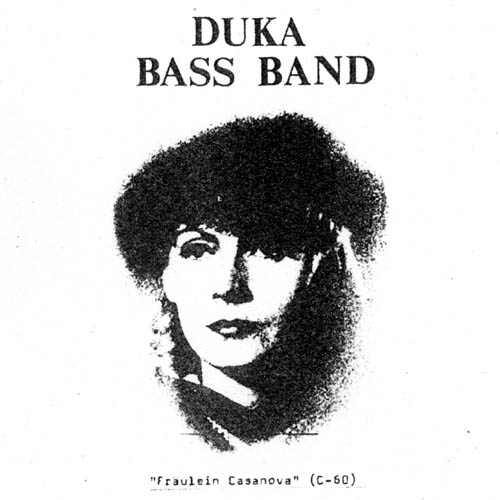 Duka Bass Band appears to be a trio consisting of Lasse Laudrup, Martin B. Klaeren and Sven Nykvist. On Fraulein Casanova,they are joined on a few tracks by Christoph Heeman and Achim P. LiKhan of HNAS, and Heeman also produced the album. The Duka Bass Band'ssound is a fuzzy, primitive clamor of clueless post-jazz improvisationsthat meander aimlessly and appear to fly in several differentdirections at once. It has a certain amateurish quality and a creepysubterranean feel that appeals to me, although I couldn't say exactlywhy. In the exclusively German liner notes, Heeman muses "Fraulein Casanovais for me a jerking step forward into the natural alreadyness ofmusic." Perhaps this dodgy AltaVista translation should not be trusted,but it's as good an explanation as any for the oddly surreal freeplaying on display here. The opening track is the seven-minute"Zauberformeln," which means 'magical formulas.' It's an aptdescription for the mysterious forces that transform the sound ofdeficiently played clarinet, organs and drums into a strange alchemicalgold that is more than the sum of its components. There are momentsthroughout Fraulein Casanova that touch on elements of firemusic improvs, belabored Shaggs-style guitar, and in the case of thelast track (whose title loosely translates to "For God, 1000 Years IsLike a Day"), a ramshackle psych-folk jam not dissimilar from therecent work of Sunburned Hand of the Man. This is my personal favoriteof the six bootlegs, and I look forward to further recordings by thismysterious post-industrial jazz trio materializing at some future point.
Duka Bass Band appears to be a trio consisting of Lasse Laudrup, Martin B. Klaeren and Sven Nykvist. On Fraulein Casanova,they are joined on a few tracks by Christoph Heeman and Achim P. LiKhan of HNAS, and Heeman also produced the album. The Duka Bass Band'ssound is a fuzzy, primitive clamor of clueless post-jazz improvisationsthat meander aimlessly and appear to fly in several differentdirections at once. It has a certain amateurish quality and a creepysubterranean feel that appeals to me, although I couldn't say exactlywhy. In the exclusively German liner notes, Heeman muses "Fraulein Casanovais for me a jerking step forward into the natural alreadyness ofmusic." Perhaps this dodgy AltaVista translation should not be trusted,but it's as good an explanation as any for the oddly surreal freeplaying on display here. The opening track is the seven-minute"Zauberformeln," which means 'magical formulas.' It's an aptdescription for the mysterious forces that transform the sound ofdeficiently played clarinet, organs and drums into a strange alchemicalgold that is more than the sum of its components. There are momentsthroughout Fraulein Casanova that touch on elements of firemusic improvs, belabored Shaggs-style guitar, and in the case of thelast track (whose title loosely translates to "For God, 1000 Years IsLike a Day"), a ramshackle psych-folk jam not dissimilar from therecent work of Sunburned Hand of the Man. This is my personal favoriteof the six bootlegs, and I look forward to further recordings by thismysterious post-industrial jazz trio materializing at some future point.
samples:
SPECK NUSSECK & DIE LEGENDAREN FETTBOYS, "DANCEMUSIC FUR DICKE BACKER"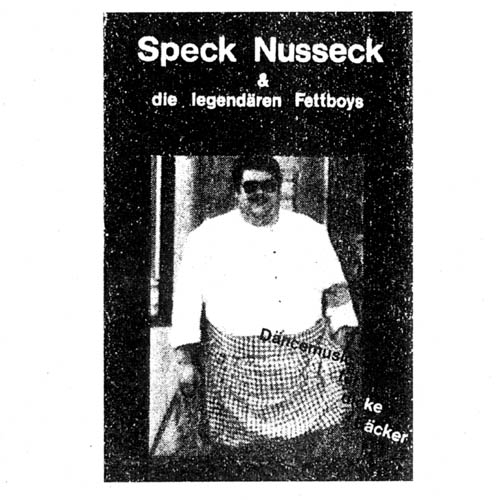 It's anyone's guess who the hell Speck Nusseck or The Legendary FatBoys are, or where they come from, or what masochistic weirdoencouraged them to record Dancemusic Fur Dicke Backer.The answers to these questions are not readily apparent, and they maynever become clear. The only thing we have to go on are the seven songscomprising Dancemusic, for which the word "annoying" seemswoefully inadequate. Plodding drum machine rhythms and randomly pluckedbass compete with vocals shouted into a megaphone backed by lamekeyboard effects which underscore the mess. I'm tempted to call thisoutsider music, but that would suggest that it is charmingly sincereand/or amateurish music that has worthwhile elements. Unfortunately,Speck Nusseck are neither charming nor sincere, and they are not worthanyone's time. They appear to be influenced by the edgy post-punk ofSection 25, the noisy effrontery of Throbbing Gristle and even themotorik beats of Neu!, but they are terribly unequal to the job ofpaying homage to their heroes. The best thing that can be said aboutthis album is that it is mercifully short, and would likely make anexcellent way to get rid of the last few people still hanging out inyour living room after the party is over.
It's anyone's guess who the hell Speck Nusseck or The Legendary FatBoys are, or where they come from, or what masochistic weirdoencouraged them to record Dancemusic Fur Dicke Backer.The answers to these questions are not readily apparent, and they maynever become clear. The only thing we have to go on are the seven songscomprising Dancemusic, for which the word "annoying" seemswoefully inadequate. Plodding drum machine rhythms and randomly pluckedbass compete with vocals shouted into a megaphone backed by lamekeyboard effects which underscore the mess. I'm tempted to call thisoutsider music, but that would suggest that it is charmingly sincereand/or amateurish music that has worthwhile elements. Unfortunately,Speck Nusseck are neither charming nor sincere, and they are not worthanyone's time. They appear to be influenced by the edgy post-punk ofSection 25, the noisy effrontery of Throbbing Gristle and even themotorik beats of Neu!, but they are terribly unequal to the job ofpaying homage to their heroes. The best thing that can be said aboutthis album is that it is mercifully short, and would likely make anexcellent way to get rid of the last few people still hanging out inyour living room after the party is over.
samples:
HNAS, "ICH KANNTE EINEN GUMMIBAUM"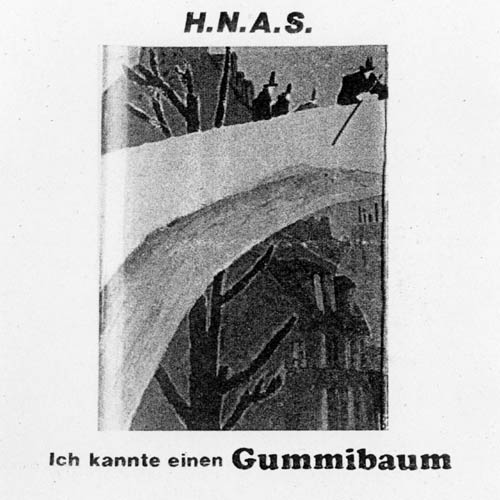 HNAS are invariably compared to Nurse With Wound, and more often thannot to the detriment of Heeman and company. It seems that they areforever doomed, relegated to an obscure footnote in the NWW story bywriters and critics, who seem unable to realize that HNAS use their ownunique strategies to portray their particular brand of audiosurrealism. HNAS does not revel in the exaggerated psychedelicgrotesqueries of Steven Stapleton's work — their tactics are sloppier,less calculated, and in many cases even stranger. The seminal krautrockband Faust is a much more analogous comparison. Heeman and Khan's pathwas paved by Faust's willfully messy LPs that cycled through disparatehalf-formed musical ideas and random piss-takes. Ich Kannte Einen Gummibaumis a good demonstration of their distinct sound. The first trackcreates a creeping quasi-rhythmic industrial atmosphere, recalling theearly work of Laibach, but Heeman's deliberately muddy production andmuffled sounds of voices, distant guitar solos and graveyard organs adda nebulous mystery belonging to HNAS alone. The second track, "Kill DenAchim" is culled from a live performance, and finds the band in agloriously anarchic phase. A woman screams violent provocations backedby oblivious, repetitive electric guitar licks and sheets of live noiseand distortion. On "Ich bin ja besser," a disco record is obscured bylayers of cacophonous whalesong. Track five loosely translates to "AWinter Without Skin Problems," in which a disintegrating chamberorchestra fights against encroaching electronic squalls. The last trackis an extended 25-minute construction combining silly-cum-sinistervocal mutations alongside nonsense percussion. The lunacy segues into alengthy section of concrete tape edits, combining impressionistic pianopieces with field recordings and samples drawn from German televisionand radio.
HNAS are invariably compared to Nurse With Wound, and more often thannot to the detriment of Heeman and company. It seems that they areforever doomed, relegated to an obscure footnote in the NWW story bywriters and critics, who seem unable to realize that HNAS use their ownunique strategies to portray their particular brand of audiosurrealism. HNAS does not revel in the exaggerated psychedelicgrotesqueries of Steven Stapleton's work — their tactics are sloppier,less calculated, and in many cases even stranger. The seminal krautrockband Faust is a much more analogous comparison. Heeman and Khan's pathwas paved by Faust's willfully messy LPs that cycled through disparatehalf-formed musical ideas and random piss-takes. Ich Kannte Einen Gummibaumis a good demonstration of their distinct sound. The first trackcreates a creeping quasi-rhythmic industrial atmosphere, recalling theearly work of Laibach, but Heeman's deliberately muddy production andmuffled sounds of voices, distant guitar solos and graveyard organs adda nebulous mystery belonging to HNAS alone. The second track, "Kill DenAchim" is culled from a live performance, and finds the band in agloriously anarchic phase. A woman screams violent provocations backedby oblivious, repetitive electric guitar licks and sheets of live noiseand distortion. On "Ich bin ja besser," a disco record is obscured bylayers of cacophonous whalesong. Track five loosely translates to "AWinter Without Skin Problems," in which a disintegrating chamberorchestra fights against encroaching electronic squalls. The last trackis an extended 25-minute construction combining silly-cum-sinistervocal mutations alongside nonsense percussion. The lunacy segues into alengthy section of concrete tape edits, combining impressionistic pianopieces with field recordings and samples drawn from German televisionand radio.
samples:
HNAS, "THE UNCOLLECTED ULTRA RARE & UNRELEASED"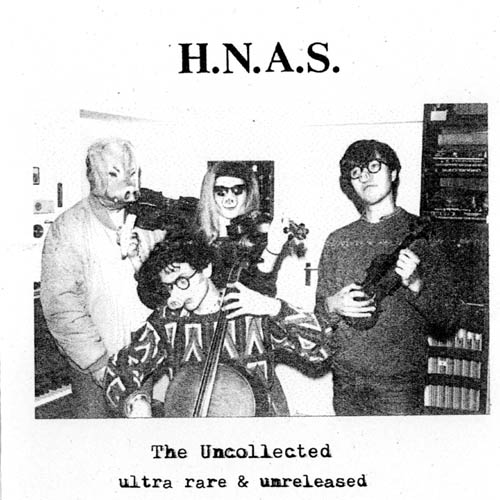 Another in a trilogy of rare HNAS cassette titles issued by G. Gonge, The Uncollectedis an odds-and-sods anthology, collecting tracks from out-of-printcompilations and rare cassettes, as well as some previously unreleasedmaterial. As such it is an uneven and incoherent listen, but with aband as unorthodox as HNAS, that's hardly a problem. Most of the tracksare in the jagged cut-and-splice style recognizable from mid-80's HNASalbums. It feels a bit like an audio version of the absurdist photo andtext collages found in early punk zines. More than once these piecesdigress into the stoned chatter and laughter of a group of youngGermans, who I can only assume to be Christoph, Achim, and friends.Recording and including this unseemly screwing-about on their albumstakes the music out of the realm of the dryly conceptual oravant-garde, and into the "anything goes" realm of DIY homeexperimentalism. That said, there is also much that is musicallyimpressive among these songs, as in the noir queasiness of "DemPetermann zu Ehren," a dark piano dirge. "Was wir von Cassetten halten4" is a phased electronic piece with looped sing-song vocals recallsearly Current 93. "Wie ein Bock am Michekstag" is similar to the workPeople Like Us, juxtaposing dialogue samples from a "Learn to SpeakSwedish" tape with a kitschy exotica loop. The final song is a rare andlovely track by Duka Bass Band: more demented post-jazz with sinisterundertones.
Another in a trilogy of rare HNAS cassette titles issued by G. Gonge, The Uncollectedis an odds-and-sods anthology, collecting tracks from out-of-printcompilations and rare cassettes, as well as some previously unreleasedmaterial. As such it is an uneven and incoherent listen, but with aband as unorthodox as HNAS, that's hardly a problem. Most of the tracksare in the jagged cut-and-splice style recognizable from mid-80's HNASalbums. It feels a bit like an audio version of the absurdist photo andtext collages found in early punk zines. More than once these piecesdigress into the stoned chatter and laughter of a group of youngGermans, who I can only assume to be Christoph, Achim, and friends.Recording and including this unseemly screwing-about on their albumstakes the music out of the realm of the dryly conceptual oravant-garde, and into the "anything goes" realm of DIY homeexperimentalism. That said, there is also much that is musicallyimpressive among these songs, as in the noir queasiness of "DemPetermann zu Ehren," a dark piano dirge. "Was wir von Cassetten halten4" is a phased electronic piece with looped sing-song vocals recallsearly Current 93. "Wie ein Bock am Michekstag" is similar to the workPeople Like Us, juxtaposing dialogue samples from a "Learn to SpeakSwedish" tape with a kitschy exotica loop. The final song is a rare andlovely track by Duka Bass Band: more demented post-jazz with sinisterundertones.
samples:
HNAS, "DIE DREHORGEL ALS FEUERSPRITZE"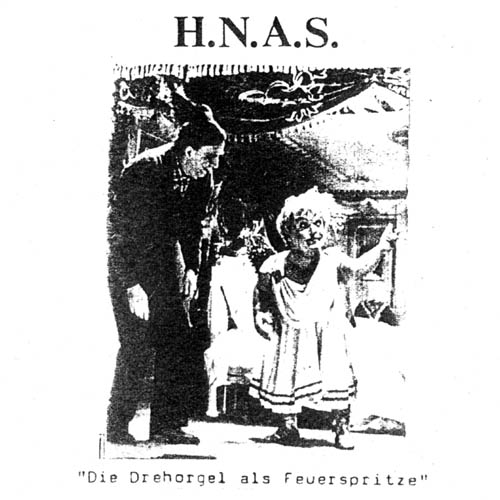 The first track of Die Drehorgel Als Feuerspritzewas recorded live in 1984, the title roughly translating to "TheParadoxes and Secret Sciences of the World." It's one of the bestpieces I've heard HNAS' prolific oevre, a murky sound sculpturecomprising long-form synth drones and gothic organ swells. The sticky,shapeless drones and burbling moogs converge into caverns filled withfloating stone obelisks that chisel strange patterns into thelistener's consciousness. The piece develops using an interior logic, adreamlike coherence that slowly asserts itself over the course of halfan hour. "Barenklammer" was recorded for an as-yet-unreleased HNASvideo, and contains some of the same source material as the firsttrack, quite reminiscent of the synthesizer arpeggiations andavant-rock noise that characterized Tangerine Dream's Electronic Meditationalbum. The third track pushes my PANIC buttons: a manipulative noisepiece that plays like Bernard Herrmann's string tribute to Whitehouse.The layered voices and random bass slaps of the last track evokes Crasscovering a Hildegaard von Bingen chant while tripping on mushrooms.This is a concentrated effort by HNAS, and its single-minded absurditymakes it the most consistent of the three HNAS CD-Rs reissued by G.Gonge. As more of these rare recordings come to light, perhaps HNAS canfinally crawl out of the long shadow cast by Nurse With Wound andreveal themselves to be every bit as unique, talented and vital.
The first track of Die Drehorgel Als Feuerspritzewas recorded live in 1984, the title roughly translating to "TheParadoxes and Secret Sciences of the World." It's one of the bestpieces I've heard HNAS' prolific oevre, a murky sound sculpturecomprising long-form synth drones and gothic organ swells. The sticky,shapeless drones and burbling moogs converge into caverns filled withfloating stone obelisks that chisel strange patterns into thelistener's consciousness. The piece develops using an interior logic, adreamlike coherence that slowly asserts itself over the course of halfan hour. "Barenklammer" was recorded for an as-yet-unreleased HNASvideo, and contains some of the same source material as the firsttrack, quite reminiscent of the synthesizer arpeggiations andavant-rock noise that characterized Tangerine Dream's Electronic Meditationalbum. The third track pushes my PANIC buttons: a manipulative noisepiece that plays like Bernard Herrmann's string tribute to Whitehouse.The layered voices and random bass slaps of the last track evokes Crasscovering a Hildegaard von Bingen chant while tripping on mushrooms.This is a concentrated effort by HNAS, and its single-minded absurditymakes it the most consistent of the three HNAS CD-Rs reissued by G.Gonge. As more of these rare recordings come to light, perhaps HNAS canfinally crawl out of the long shadow cast by Nurse With Wound andreveal themselves to be every bit as unique, talented and vital.
samples:
Read More
- Administrator
- Albums and Singles

Since their creation in 2005, The Skull Defekts have taken their base of classic rock with massive guitar riffing, and infused it with their interest in circular composition, drone, tribal music, Indian ragas, '60s minimalism, and experimental music from numerous ages. The band's lineage is nearly unparalled amongst their peers with members having served time in Union Carbide Productions, Kid Commando, Alvars Orkester, Satan Power, Oceans of Silver & Blood, Anti Cimex, Cortex, Trapdoor Fucking Exit, 8 Days of Nothing, and countless others. Their collaborations are no less notable with members working with Pan Sonic and Mats Gustafsson. Peer Amid, their third "rock" album, finds the band augmenting their line-up with a new fifth member, Lungfish vocalist Daniel Higgs.
Recorded at The Dustward Studio in Stockholm by Stefan Brainstrum, Peer Amid is their strongest effort to date. The arena-sized riffs of "No More Always" seep with an undeniable swagger, briefly catapulting the bands cyclic riffs into a frenzy. The intensity of "Gospel of the Skull" is driven by a tension created by the push and pull of Higgs vocals and mostly restrained guitar. Some may be familiar with this song as it was performed with a full symphony orchestra as part of the Gothenburg String Theory series that also featured the likes of Jose Gonzalez and El Perro Del Mar. The guitar lines of "Fragrant Nimbus" would make an apt soundtrack for a retro action movie on their own. When coupled with the foreboding words of Daniel Higgs, things rapidly move in another direction, fraying and shattering as his warnings become more explicit. The combination of Higgs' lyrics and singular vocals are the perfect foil for The Skull Defekts myriad of talents. Peer Amid is a rock record, made by musicians who have always reveled in exploration, and made for a head that can accommodate the 360 degree turn.
The Skull Defekts are:
Henrik Rylander (Drums // Electronics), Joachim Nordwall (Guitar // Vocals // Analog Synths), Jean-Louis Huhta (Percussion // Effects // Electronics), Daniel Fagerstroem (Guitar // Vocals // Electronics), and Daniel Higgs (Vocals // Various Instruments).
Read More
- Administrator
- Albums and Singles

Artist: Machinefabriek
Title: Vloed
Catalogue No: CSR138CD
Barcode: 8 2356649932 9
Format: Digipak
Genre: Drone / Guitar Ambient
Shipping: 29th November
'Vloed' is a collection of (slightly edited) live performances, recorded between 2006 and 2008 in Amsterdam and Den Haag.
"All performances find Machinefabriek in fine form, offering up thick billows of warm guitar shimmer, fluttery staticky ambience, and at one point some uncharacteristically heavy super distorted metallic guitar, but here, it's not so much metal as simply a mighty drone, thick and throbbing and super intense. There are long stretches of near silence and super minimal high end drone, glimmering slow building crescendos, squalls of distorted choral buzz, warm whirring metallic reverberations, shimmery and dense black dronemusik, all the stuff we love about Machinefabriek" (Aquarius).
Beautifully remastered with a 20-minute bonus track, 'Vloed' captures the immersive live experience of a Machinefabriek concert.
Presented in a stunning matt digipak with modified artwork.
Tracks: 1. Allengskens (18:03) | 2. Drifjgzand (13:16) | 3. Vrijhaven (21:12) | 4. Vloed (22:08)
Read More
- Administrator
- Albums and Singles

Artist: Various Artists
Title: We Bring You A King With A Head Of Gold
Catalogue No: CSR100CD
Barcode: 8 2356649942 8
Format: Jewelcase
Genre: Traditional Folk, Dark Folk, Ballads
Shipping: 29th November
The follow-up to our award winning Folk compilation "John Barleycorn Reborn" from 2007. 34 tracks and 146 minutes of music from the best of current British Folk artists.
The raw green of spring is burnished through midsummer into the baked golden crust of August, the headlong vigour of new growth slowing, ripening into a sagging, fecund fullness. Crows wheel low over a cornfield, inkblots spilt on the wide blue sky, their ragged cries cracking the drowsy haze of high summer. Cornstalks rustle and whisper secretively, heads nodding sagely in the light breeze, spread resplendent over the land like the bushy sun-bleached beard of Barleycorn himself, basking in the afternoon heat. The image fades, dispersing into the ripples of Mimir’s black mirror, and now the harvest appears as the radiant blonde braids of gentle Sif, Norse goddess of the corn, ever-faithful wife of Thor, patroness of fidelity, of promises kept. Again the mirror ripples, and now the corn forms the mane of a magnificent horse, surging over the earth, alive with energy, bearing the memory of innumerable harvests past and the promise of harvests yet to come, past and future radiating out in all directions from this perfect, poised moment of completion. It’s time to reap. (Simon Collins)
Tracks: Disc 1: 1. Barron Brady - 'Earthen Key' | 2. Laienda - 'Little Drummer Boy / Anvil' | 3. The Rowen Amber Mill - 'Blood And Bones (Ciderdelica Mix)' | 4. Tony Wakeford - 'The Devil' | 5. Kate Harrison - 'England' | 6. Drohne - 'The Hooden Horse / An-Dro' | 7. Corncrow - 'The Cutty Wren' | 8. Sproatly Smith - 'I Shall Leave You There' | 9. Tinkerscuss - 'Black Sarah' | 10. Cerunnos Rising - 'Hear It With My Heart' | 11. Mama - 'The Fool Of Spring' | 12. Magicfolk - 'Green Man' | 13. Wyrdstone - 'Lost At Ty Canol' | 14. Emil Brynge - 'Devon Dream' | 15. Kim Thompsett - 'Lords And Ladies' | 16. Dragon Spirit - 'Always Be Ours' | 17. Philip Butler And Natasha Tranter - 'Jack The Mommet' | 18. Touch The Earth - 'Ancient Landscapes'
Disc 2: 1. Relig Oran - 'Ye Mariners All' | 2. Autumn Grieve - 'Within Hollows' | 3. Ian McKone - 'Searching For Lambs' | 4. John Parker - 'Manningham Blues' | 5. Rattlebag - 'The Tyburn Sisters' | 6. The Fates - 'The Song Of The Fates' | 7. The Hare And The Moon - 'The Three Ravens' | 8. The Kittiwakes - 'Lynx' | 9. Venereum Arvum - 'Robin Sick And Weary' | 10. Telling The Bees - 'Fithfath' | 11. Richard Masters - 'The Wind Knows' | 12. Demdyke - 'Mother Carey's Chicks' | 13. Beneath The Oak - 'Oh Earthly Man' | 14. Sedayne : Sundog - 'A Wee Brown Cow' | 15. Ruby Throat - 'Swan And The Minotaur (Troubled Man)' | 16. Jennifer Crook - 'Ribbons Of Green / The Dream Waltz (Live)'
Read More
- Administrator
- Albums and Singles
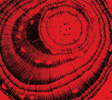
On this single track album, Tommi Keränen, who is also one half of the infamous Norwegian noise duo Testicle Hazard, throws down a bit over a half hour of heavily dynamic electronic noise that destroys speakers with the best of them, but with a level of complexity and variation that many other noise artists seem to ignore.
Immediately the track launches into heavy, raw buzzsaw tones and layers of phased sound constructed atop of it.While it starts out loud and messy, it continues to build even further until the foundation can barely sustain all of the noise that it supports.There are brilliant balances struck throughout:piercing, pure sine waves with short blips of unidentifiable sonic trash; monolithic concrete slabs of noise with rapidly undulating and changing passages.
While the static noise tends to be a dominant feature throughout, it never becomes overbearing, with a constantly cycling crowd of hyperkinetic squelches, overdriven crunches and buzzing passages to balance out the pure feedback.There’s also a healthy selection of bent and mangled pure tones in there to counterbalance the mess.
The biggest change is apparently about 13 minutes in, where the track is pulled apart into some sporadic tones that sound like spastic techno breakdown moments, along with spots of ultra high frequency high pitched frequencies that are reminiscent of the interstitial bits between songs on those extremely early Whitehouse albums.This is only a brief respite, if you could even call it that, before it goes full bore into rising and falling noise tones for the remainder of the album.
Keränen has succeeded in crafting an album that retains the best qualities of the harsh noise scene (and its many subcategories) without really demonstrating any of the annoyances.There isn’t a sense that the recording is extremely loud in order to just be "extreme," but it retains the cojones one would expect from a noise album.The dynamic selection of sounds and changes in structure keep it varied, and there’s enough variation in here to possibly even pique the interest of non harsh noise fans.Those who covet their Alchemy Records collections and Macronympha tapes will still be all over this too though, so it has hardcore cred as well.
samples:
 
Read More
- Administrator
- Albums and Singles
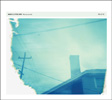
With its hushed synthesis of traditional instrumentation and lightly processed field recordings, Monocoastal follows along recent trends of Seaworthy & Matt Rösner and Taylor Deupree's works on the 12k label. They're carving out a niche that is alien, but familiar, and is as complex as it is sparse, weaving the recognizable with the unknown.
From the carefully treated textures on the disc to the washed out Polaroid photo on the cover, this album is one of taking the familiar and using it to build something entirely new.A recurring motif of the disc is one of water and the coast, unsurprising given that it was Fischer’s movements up and down the west coast of the USA that inspired it."Wave Atlas" marries water droplets that echo forever with hazy, warm melodies."Monocoastal (Part 1)" is all weathered, gentle tones that seem to come from every direction, mixed with subtle birdsongs.The sound becomes more complex when what resembles a shimmering layer of accordion and glassy ringing bells are added, but it stays fully restrained.
"Wind and Wake" has an underlying bed of sound that constantly rises and falls like the undulations of the sea, with a looming melody that enshrouds like a fog, surrounding the entire song with a delicate digital accompaniment."Cascadia Obscura" also mixes some seemingly recognizable sounds with unknown ones, where wind chimes and vibrating tension lines set the stage, only to have the piece closed with sharp strummed guitar notes or the scraping of scissors.
That obscurity when it comes to the sources of a sound is what makes this album so captivating.Fischer's careful use of found sounds and field recordings coupled with a very light touch when it comes to processing goes a long way.The sounds are left pure enough to seem natural, but twisted in such a way as to resemble something entirely different, but never to a point of pure abstraction. This, coupled with a careful use of low fidelity elements give a rustic, yet alien quality to the sound.
In the latter moments of the album the tone begins to change, with "Shape To Shore" adding lower register, almost bass guitar like notes that lean more towards the melancholy side of emotion, and the stuttering, glitchy elements of "Between Narrow and Small" add a bit of discord and chaos, while still retaining the haunting beauty of the rest of the tracks.
Like other recent works on the label, Marcus Fischer is showing an extreme skill in creating sounds that seem to have their source in the natural world, but ones that are nearly impossible to identify.The delicate, decaying beauty of these textures and tones should not be missed.
samples:
 
Read More
- Administrator
- Albums and Singles
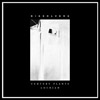
Chicago's Locrian have actually been a bit less prolific this year, really only releasing two brilliantly cohesive albums, Territories from earlier this year (originally on LP, now available on CD), and the upcoming double disc The Crystal World. Other than those, they've been relatively quiet, even with the addition of full time percussionist Steven Hess. On this split with New York's Century Plants, they continue their emphasis on abstracting the concept of "metal", with each band taking different approaches, but achieving a common goal.
Century Plant's two pieces veer more towards the psychedelic, while retaining a darkness that fits well with the Locrian material on the other side."Fading Out" pairs string bending guitar improvisations with distant, cavernous clattering and a smattering of random found sounds.While the opening is sparse, the latter segments layer on a mass of ambient textures and more overt guitar work.
"Delirium" has a lighter feel to it, with soaring tones that feel more ebullient than anything else on the album with tape echoed outbursts occasionally snaking through.A darker industrial squall guitar sound eventually becomes the focus, sucking the light from the piece slowly but surely.Straddling the line somewhere between black metal and noise, the track takes on a sound all its own.
The Locrian half of the LP feels more in-line with their work from a few years ago as opposed to their recent output of more song-like pieces.This is especially notable with "On A Calcified Shore," with its high pitched, sharp tone and droning bass lingering in the background.As it builds, it becomes a hazy realm of echoing, reverberated guitar tones with the occasional shrill passage jumping out.It’s definitely more droney than their recent work, but it is a great slasher flick soundtrack.
"Omega Vapors" has the same tense, nightmarish sensation going for it, but instead of echo and feedback it's more of simple synth melodies and repetitive, two note guitar sequences that lead the way, creating an almost carnival like atmosphere, but a very evil one, with menacing guitar feedback and layers of synth rising up from the muck to eventually swallow the entire track.
I’m not sure if all copies feature it, or only ones direct from the label, but there was also a CDR included with the LP of all four tracks remixed by Rambutan (one of Century guitarist Eric Hardiman's side projects).The tracks essentially are pulled into a more electronic, experimental based field as opposed the more guitar heavy originals.The balance between original and new is nicely struck, and the four pieces are a different take on the original works.
With both bands working in similar, but different ways on the deconstruction of heavy metal guitar sounds, the two halves of this LP compliment each other nicely.Even though it is a split release, rather than a collaboration, there is a strong sense of unity between them.Between the more spacey Century Plants side and the sinister Locrian half, it’s a wonderful album of variations on a theme.
samples:
 
Read More
- Administrator
- Albums and Singles
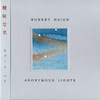 As enjoyable as Robert Haigh's albums have been, they never seemed to capture that same aching beauty of his classic albums from the '80s (both under his own name and as Sema). This latest album changes all that. The delicate touch and fragile melodies, which defined his best work, are both present. Sombre without being dour, reflective without being depressing, this represents Haigh's finest work in years.
As enjoyable as Robert Haigh's albums have been, they never seemed to capture that same aching beauty of his classic albums from the '80s (both under his own name and as Sema). This latest album changes all that. The delicate touch and fragile melodies, which defined his best work, are both present. Sombre without being dour, reflective without being depressing, this represents Haigh's finest work in years.
The album begins sombrely with the title track; slow and nocturnal it sets the pace and the mood for the album. Like most of Anonymous Lights, this initial piece is short (only this and one other piece last longer than three minutes). Each tune is a vignette full of moonlight and dead calm. The influence of Erik Satie and Claude Debussy is obvious throughout but Haigh's unmistakable compositions could not be confused with scores from either composer. The likes of "Fugitive Moonlight" gently dances like light rain, as hypnotic as the natural sound but full of a supernatural magic and evoking the melodic powers of Satie and Debussy without aping their respective styles.
Elsewhere, "Berlin Kino" shows Haigh's superb ear for melody as he crafts a stunning constellation of notes over the pitch black of a repeating rhythm on the lower keys. The album's title and the starry quality of the notes both here and on pretty much every other piece on Anonymous Lights give the impression of being an observer, either a traveller gazing at a distant city or an astronomer casting their sight down the body of a telescope into the infinite heavens. This idea comes through strongest during "Moon Blue Crooks" which also incorporates the sound of a wind gusting through the music giving the feeling of in an old house, ear against the wall listening to a haunting (or haunted) piano as the weather beats the outside of the building.
At the end of Anonymous Lights is a lengthy piece, "Book of Fixed Stars," which evokes the same ghostly feelings as were present in the grooves of those old Sema records. Over the course of the piece, Haigh takes simple building blocks of melodic clusters and puts them together in cryptic, beautiful ways. The already slow pace of the album freezes and almost reaches a stop as Haigh lets each note form fully and ring; the reverberation blurring into the next note and creating a transfixing audio painting.
To call this music beautiful is an understatement. Blixa Bargeld once said that "arms would not be able to stretch as far as necessary
to form an adequate gesture for beauty." I like to think that Haigh has managed to form that gesture through his playing, stretching his arms along an infinite piano keyboard to create a true artistic representation of beauty at its purest.
samples:
Read More


